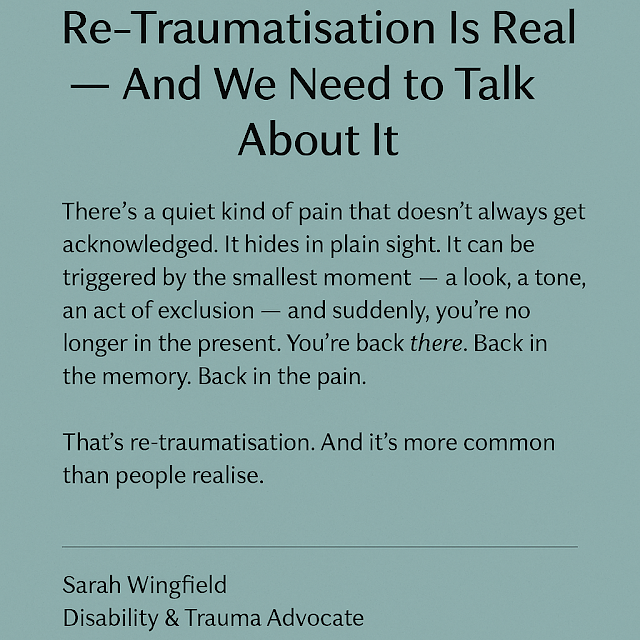Re-Traumatisation Is Real — And We Need to Talk About It:
Re-Traumatisation Is Real — And We Need to Talk About It
There’s a quiet kind of pain that doesn’t always get acknowledged. It hides in plain sight. It can be triggered by the smallest moment — a look, a tone, an act of exclusion — and suddenly, you’re no longer in the present.
You’re back there. Back in the memory. Back in the pain.
That’s re-traumatisation.
And it’s more common than people realise.
What Is Re-Traumatisation?
Re-traumatisation happens when something in the present activates the same emotional or physiological response you had during a past traumatic event. It can be loud — like a meltdown, panic attack, or visible distress — but more often, it’s quiet. It looks like shutting down. Dissociating. Going non-verbal. Suddenly freezing. Shaking. Tears you didn’t expect.
It’s the body remembering. It’s the nervous system going, “We’ve been here before — and last time, we weren’t safe.”
This isn’t weakness. This isn’t overreacting. This is biology. Psychology. Survival.
How Society Fails Survivors
The saddest thing is this: most retraumatisation doesn’t just come from the trigger. It comes from how people respond to you afterward.
It’s the security guard who rolls their eyes instead of helping. It’s the event organiser who tells you to “calm down” instead of offering a chair. It’s the bystander who stares at you in discomfort and walks away. It’s being treated like you’re the problem, when in reality — you’re having a completely understandable response to a history of harm.
So often, people choose power, control, or convenience over compassion. And that’s where the deepest damage is done.
This Is a Call for Compassion
We need a cultural shift — where trauma-informed care isn’t just for therapists, but for everyone. Where being kind isn’t conditional. Where support is offered without suspicion.
What if we asked:
“Are you okay?”
“Would you like some space?”
“Do you want me to sit with you?”
“Is there anything you need?”
What if people were slower to judge and quicker to care?
Re-traumatisation isn’t the survivor’s fault. It’s a mirror — showing us where empathy is missing.
If You’ve Been Re-Traumatised
Please know: your reaction was valid. Your pain makes sense. You are not “too much.” You are not broken. You are responding to something that hurt you — possibly many things, over a long period of time.
You are allowed to protect yourself. To rest. To grieve. To set boundaries. To speak out.
And you are never alone in this.
Final Thoughts
People don’t need to understand every detail of your trauma to treat you with dignity.
They just need to care.
So to anyone reading this — be gentler. Be softer. Be someone who doesn’t retraumatise others with your words or actions.
This world has enough pain. Let’s not be the reason someone adds more to what they’re already carrying.
We can do better. And we must. 🫶🏻
Sarah Wingfield
✊ Disability & Trauma Advocate
🖤 Survivor. Writer. Human.
✨ Fighting for a kinder, safer world through truth and compassion.
#EradicateAbleism #disabilityinclusion #strongertogether #disability #disabilityawareness #disabilitysupport #disabilityrights
Alt text:
A digital graphic with a muted teal background displays the title “Re-Traumatisation Is Real — And We Need to Talk About It” in bold black text at the top. Below the title is a paragraph explaining that re-traumatisation is a quiet pain that hides in plain sight and can be triggered by small moments like a look, tone, or act of exclusion, causing someone to mentally return to a traumatic memory. The paragraph ends with the line, “That’s re-traumatisation. And it’s more common than people realise.” At the bottom, separated by a thin black line, the author’s name and title are shown: “Sarah Wingfield, Disability & Trauma Advocate.”


